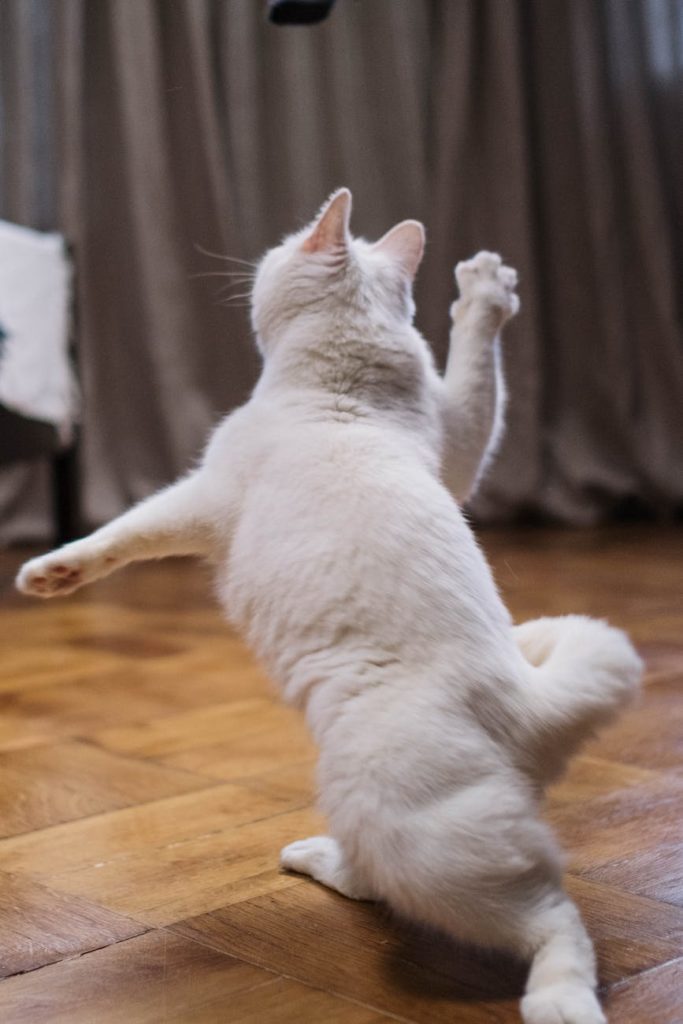End A Cat Fight
As pet owners, we love our cats like family. However, sometimes our furry friends can get into disagreements that lead to fights. If you are a cat owner, it’s important to know how to safely break up a cat fight to prevent injuries to both cats and humans.
Table of Contents
Here are some steps you can take to safely break up a catfight:
Feline Diplomacy: 10 Proven Tactics to Peacefully End a Cat Fight
Cats, with their feisty personalities and unique communication styles, occasionally fall into conflict. Whether it’s a scuffle over territory, a disagreement during playtime, or jealousy over a new pet, the resulting cat fight can be concerning for both the cats involved and their human companions. Understanding how to peacefully intervene and restore harmony among your feline friends is crucial. In this post, we will explore ten proven tactics to effectively and peacefully end a cat fight.
1. Stay Calm and Collected
When witnessing a cat fight, the initial impulse for many is panic. However, remaining calm is essential. Cats can sense their owner’s emotions, and your anxiety may only escalate the situation. Instead of rushing in, take a deep breath and assess the environment. End A Cat Fight. This moment of calm allows you to gather your thoughts and approach the situation with a clear mind.
Next, observe the behavior of both cats. Are they growling, hissing, or simply wrestling? Understanding the dynamics of their altercation can help you determine the appropriate response. End A Cat Fight. By maintaining your composure, you can act decisively without exacerbating the situation.
2. Use a Gentle Distraction
Distractions can effectively redirect a cat’s focus and diffuse tension. Start by engaging both cats with a familiar toy or treat. Utilize rattling noise-making toys, feather wands, or even a laser pointer to draw their attention away from the confrontation. End A Cat Fight. Make sure to keep it light and fun, as this reinforces positive associations with each other instead of adversarial behavior.
Moreover, be mindful of positioning when using a distraction. Place the toy or treat at a distance from both cats so they can safely approach it without feeling threatened. End A Cat Fight. The goal is to create a peaceful diversion that helps them forget their differences temporarily.
3. Employ the Power of Scent
Cats rely heavily on scent for communication. Introducing familiar scents can help bridge the gap during a confrontation. End A Cat Fight. Try rubbing a soft cloth with a scent from each cat, and allow them to sniff it. This technique can remind each cat of the other’s presence in a non-threatening manner and potentially reduce aggression.
Furthermore, consider using synthetic pheromones designed for calming pets. Products like Feliway diffusers can help establish an atmosphere conducive to relaxation and peace. By surrounding your cats with familiar scents, you can ease their anxiety and promote harmony.
4. Provide Separate Spaces
When fighting occurs, it may be beneficial to give the disputing cats some space. Creating a safe retreat allows both cats to retreat to their corners and cool off. Ensure that each cat has their own designated space with food, water, and a litter box. End A Cat Fight. This separation reduces territorial disputes and gives each cat the opportunity for solitude.
After a cooling-off period, reintroduce the cats gradually. Allow them to observe one another from a distance before allowing close interaction. By creating a safe environment, you empower your cats to control their interactions and establish boundaries.
5. Consider the Thump Method
The “thump method” might sound a bit drastic, but it can be an effective way to stop a cat fight. This tactic involves making a quick, loud noise—like clapping your hands, banging a pot, or using an air horn—to startle the cats and interrupt their fight. It’s crucial, however, that the sound is not frightening to the extent it creates further anxiety. The objective is to gain their attention without causing them undue stress.
Once you’ve succeeded in interrupting the fight, quickly redirect their focus to a distraction. The goal is to prevent any lingering aggression that could lead to renewed conflict. End A Cat Fight. Remember that this method is best suited for situations where immediate intervention is necessary, rather than being a proactive strategy.
6. Utilize the Water Strategy
Water is a natural deterrent for many cats, as they generally dislike getting wet. If the situation allows for it, using a spray bottle filled with water can calm the chaos. The trick is to spray the water at the ground near the cats, rather than directly on them. This technique serves as a gentle reminder that their behavior is unacceptable.
However, use this approach with caution. Overusing water as a deterrent can create fear and stress in your cats. End A Cat Fight. Be mindful of how they react, and limit the method to situations that require immediate action to prevent injury or escalation.
7. Intervene Verbally
Sometimes, an assertive vocal intervention can help settle a cat fight. Yelling at the cats can escalate the situation, but using firm, calm language can help. Say their names in a firm voice to get their attention, then follow it up with a command like “stop” or “no.” This verbal intervention serves as a gentle reminder that fighting is not acceptable behavior.
If one cat has a tendency to be more dominant, redirect your focus on that cat as well. Emphasize positive reinforcement when they engage in non-aggressive behaviors. End A Cat Fight. This technique helps reinforce good interactions and encourages peaceful coexistence.
8. Reintroduce Gradually
Returning cats to a peaceful coexistence requires a carefully planned approach. Following a fight, consider implementing a gradual reintroduction process. Start by keeping the cats separated for a few days. During this time, allow them to eat at the same time but in different locations, fostering a sense of safety without direct interaction.
Once they seem more comfortable, gradually allow them to see each other through a barrier, such as a cracked door or a baby gate. Reward positive interactions with treats and praise. End A Cat Fight. This method of re-establishing ties encourages a sense of security and reduces fear of future confrontations.
9. Encourage Cooperative Play
Once the atmosphere calms down, it’s time to reintroduce cooperation into their interactions. Engage both cats in a positive and playful manner, using toys that require teamwork, such as feather wands or interactive treat dispensers. This cooperative play fosters bonding and helps each cat associate positive feelings with the other.
Moreover, try rotating toys periodically to keep their play sessions fresh and exciting. End A Cat Fight. The goal is to create positive experiences that counterbalance any conflicts that may arise. By encouraging joyful interactions, you lay the groundwork for peaceful relationships.
10. Seek Professional Help If Necessary
While many cat fights can be resolved with intervention, there are certain situations where seeking professional help becomes essential. Behavioral issues, particularly among felines, can be quite complex and often require expert insights. End A Cat Fight. Consulting with a veterinarian or an animal behaviorist can provide invaluable information regarding your cats’ unique dynamics, helping to understand the underlying causes of their conflicts.
These professionals have the expertise to diagnose a variety of issues, such as territorial disputes, anxiety, or even health-related concerns that might be contributing to the aggressive behavior. For instance, a cat that suddenly becomes hostile may be experiencing pain from an undetected injury or illness, which a vet could identify. On the other hand, an animal behaviorist can offer tailored behavioral modification strategies that can help ease tensions and promote harmony in your home.
Additionally, having an objective third party assess the situation can help you develop more effective management techniques and improve the overall well-being of your pets. Remember that every cat is an individual, and tailored approaches often yield the best results. In cases of persistent aggression, addressing the issue sooner rather than later can prevent long-term damage to relationships between your beloved pets.

Addition
Additionally, consider that certain breeds may exhibit more aggressive behaviors than others. Understanding your cats’ unique personalities helps tailor your approach. By tackling underlying issues with professional guidance, you can foster positive outcomes that ensure lasting peace in your home.
Cultivating Calmness in Your Home
Ending a cat fight is a challenge that requires patience and understanding. By practicing these ten proven tactics, you not only help stop conflicts in the moment but also work toward fostering a harmonious living environment for your feline friends. Remember to stay calm, use distractions wisely, and provide separate spaces when necessary. Most importantly, consider consulting professionals for guidance when issues persist.
Your commitment to ensuring that both cats feel safe and valued will significantly reduce the likelihood of future conflict. End A Cat Fight. Embrace the journey towards feline diplomacy, and with time and effort, your cats can learn to coexist peacefully. With dedication and the right approach, you can enjoy a serene home free from the chaos of cat fights.
Step 1: Stay Calm
Cats are sensitive creatures that can pick up on your emotions with remarkable accuracy. They have an innate ability to sense fear or anxiety in their human companions, and if you approach a catfight with these negative feelings, it will only escalate the situation further. When tensions rise between cats, whether they are play-fighting or genuinely vying for territory, your demeanor can influence the outcome significantly.
Take a deep breath, allow yourself a moment of reflection, and stay calm. End A Cat Fight. Maintaining a relaxed and composed demeanor not only helps to de-escalate the situation but also provides a sense of security to the cats involved. By approaching the situation with a clear mind, you can assess the scenario more effectively, identifying whether intervention is necessary.
If you find yourself in the midst of a catfight, observe their body language closely. Look for signs of aggression or fear, and determine if separating them is required. Remember, your goal is to create a peaceful environment. By staying serene, you’re not only protecting your furry friends but also fostering an atmosphere that encourages understanding and cooperation among them. This calmness can help them feel more at ease and may even lead to a resolution on their own.
Step 2: Make Loud Noises
Loud noises can be an effective way to distract fighting cats. When you encounter a situation where cats are engaged in a contentious battle, making a sudden and unexpected noise can startle them enough to break their focus on each other. Simple actions like clapping your hands or stomping your feet can create a sharp sound that captures their attention. Alternatively, using a loud whistle can be even more effective, as it produces a piercing noise that can cut through the background sounds.
It’s important to remain calm yourself, as your energy can influence the cats’ reactions. If the noise is loud enough to startle them without causing fear, it often disrupts the fight and creates the perfect opportunity for the cats to disengage. Once the fight is interrupted, you can then take a moment for the cats to calm down before separating them, if necessary.
Remember, the goal is to create a momentary distraction rather than to frighten the cats into hiding. End A Cat Fight. After the situation has de-escalated, provide reassurance and comfort to both cats, and consider giving them some time apart to cool down, allowing for a more peaceful environment once again.
Live Pee Free! Odor Eliminator 100% Eliminates Pet Odor on Contact. 20% Off. No Enzymes, No Fragrance, No Detergent, No Bleach – Safe for Kids and Pets.Step 3: Use Water
Another effective method to break up a catfight is by using water. Fill a spray bottle with water and carefully spray the cats from a safe distance. End A Cat Fight. The sudden spray of water will startle them, interrupting their aggressive behavior, and redirecting their attention away from the altercation. It’s crucial to ensure you’re at a safe distance to avoid any potential backlash from the cats, as they may not take kindly to being startled.
This technique is especially beneficial when the cats are fighting over resources such as food, toys, or territory, as their focus on the items can lead to heightened aggression. End A Cat Fight. When employing this method, be mindful of the environment; try to avoid spraying water near sensitive areas like outlets or electronics.
Additionally, ensure that both cats are in a space where they can easily retreat if they feel threatened. After using water to diffuse the situation, give the cats some time apart to calm down and assess the dynamics. It can also be helpful to understand the triggers behind their behavior, which may involve resource scarcity. End A Cat Fight. Ultimately, this technique can provide a temporary solution, but addressing the root causes of the conflict will help foster a more harmonious relationship between your furry friends.
Step 4: Use a Barrier
If the cats are still fighting and can’t seem to settle their differences, you can try to separate them using a physical barrier. This method is often effective in preventing further confrontation. End A Cat Fight. A piece of cardboard, a lightweight screen, or even a large piece of furniture can be used to create a temporary dividing wall between the two felines. Position the barrier in such a way that it completely blocks their line of sight, which can help reduce their stress and agitation.
This technique gives the cats a chance to calm down and relax without the constant presence of the other. It’s important to ensure that the barrier is sturdy enough to withstand any attempts to push through or climb over it. End A Cat Fight. While the cats are separated, take the opportunity to observe their behavior from a distance. Look for signs of relaxation, such as grooming or settling down in a comfortable position, which indicate they might be ready for a more gradual reintroduction.
Remember to provide each cat with their own space, food, and resources on either side of the barrier so that they feel secure and comfortable during this time. End A Cat Fight. Patience is key, as the goal is to create a peaceful environment where they can coexist harmoniously in the future.

Step 5: Seek Professional Help
If the catfight escalates and becomes particularly aggressive, or if you observe that one of the cats is injured, it’s crucial to take immediate action and seek professional help. Injuries, even minor ones, can quickly lead to more severe health issues, so it’s essential to have a professional assess the situation. End A Cat Fight. Contact your veterinarian as soon as possible for an evaluation of the injured cat. They can provide necessary medical treatment and advice on how to care for your pet during recovery.
In addition to veterinary assistance, consider reaching out to an animal behaviorist. These professionals specialize in understanding the underlying causes of aggression in animals. End A Cat Fight. They can offer valuable guidance on how to manage and modify the behavior of your cats to prevent future conflicts. A behaviorist can help you develop a tailored plan that may include environmental changes, behavior modification techniques, and socialization strategies to create a more harmonious living situation.
Remember, addressing aggressive behavior promptly is vital to ensuring the safety and well-being of all pets involved. End A Cat Fight. Seeking professional help not only aids in resolving the immediate issue but also contributes to a healthier and more peaceful environment for your cats in the long run.

In conclusion, breaking up a catfight can be a stressful and potentially dangerous situation. It’s important to approach the situation with a clear mind and take steps to keep both cats and humans safe. End A Cat Fight. Remember to stay calm, make loud noises, use water, use a barrier, and seek professional help if necessary.



